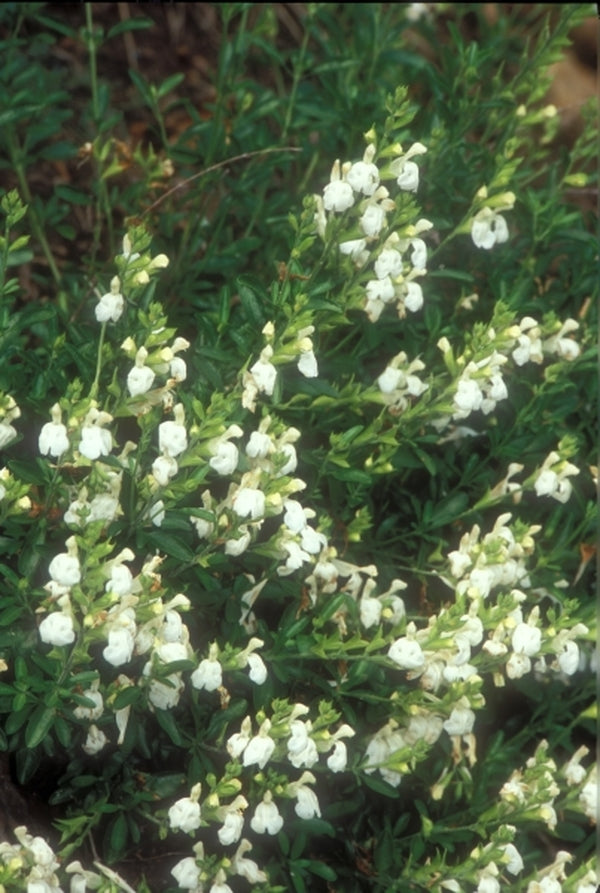Salvia greggii 'Texas Wedding'
White Texas Sage
This plant is not currently for sale. This is an archive page preserved for informational use.
Shop Available SalviaItem #: 889
Zones: 5b to 10b, at least
Dormancy: Evergreen
Height: 24" tall
Origin: United States
Pot Size: 3.5" pot (24 fl. oz/0.7 L)
(aka: Salvia greggii 'Alba') This plant had been tossed around the country for years without a legitimate cultivar name, so in 2006 we officially christened it Salvia greggii 'Texas Wedding'. Salvia greggii 'Texas Wedding' is a very hardy, upright sub-shrub to 2' tall x 2' wide. Adorning the deer-resistant woody stems and small, narrow, evergreen leaves are masses of hummingbird-attracting white flowers produced continuously from late spring into fall, except for a floral slow-down in the hottest part of midsummer. Well-drained soils are best for all Salvia greggii.
Maintenance:
Salvia greggii and its close cousin Salvia microphylla and hybrids between the two, Salvia x jamensis, are woody shrubs. They bloom for about six months but are not self-cleaning and the spent flower stalks are retained until a tidy minded gardener comes along and trims them off. The peak time to do this is late winter. At this time the shrubs are cut back by a half to two thirds to remove the dead tops of the plant. This does not require precision. It is a method meant to allow quick clean up of these woody salvias. Of course, any totally dead stems should also be removed. The health of the plant will not be compromised if it is not cleaned up but one will be viewing the current year's flowers amongst last year's dead flower stalks. This is the only routine maintenance that these salvias need.
The selections of Salvia greggii, Salvia microphylla and Salvia x jamensis vary in their vigor. The most vigorous individuals might occasionally need to reined in where they have spread too far if space is limited. But these are the exception to the rule in these normally stationary plants. Excess plants can be dug out and replanted elsewhere if desired.
Growing Conditions:
Salvia greggii, Salvia microphylla and Salvia x jamensis are sun lovers; more sun the better. They are also drought tolerant but also tolerate wet spells if provided with adequate drainage:not excessive drainage, just any soil where water doesn't pool after a rain. They are often called "Autumn Sage" for their peak bloom is late summer into fall, though in the humid eastern US they tend to bloom continuously from spring into fall. Extended dry spells in summer can decrease blooming as is typical in their native range of Texas and Mexico.
Nomenclature:
The genus Salvia consists of about one thousand species. A few are annuals, most are perennial. The perennial species can be either herbaceous or woody. The woody perennial species are most often shrubs though there are some salvias that are trees. Gardeners from cold climates are often surprised to learn that some salvias are shrubs.
Natural Impact:
Salvia greggii, Salvia microphylla and Salvia x jamensis can be counted on for nearly six months of bloom in a wide range of color. They are the type of long blooming plant that are good foils for the show stoppers that come and go such as lilies that are in bloom for a few weeks. They are also highly favored by hummingbirds and other pollinators. These features and their low-maintenance make them very valuable part of a sunny garden, including a xeric garden.



-
Related Articles
- How to Build a Pitcher Plant Bog
- Dear Deer - We're Closed for Dinner
- The Top Hummingbird Attracting Plants for Your Garden
- Cutting Through the Jungle - Native Plants Myths and Realities
- Perennial Salvia Plants - Ornamental Sages for the Garden
- Name that Plant - The Misuse of Trademarks in Horticulture
- When Should I Plant My Plants?
- The Top 6 Coolest Blue Salvia for the Garden
- The Top 25 Butterfly Plants
- How to Build a Butterfly Garden
- Hummingbirds in the Garden
-
Other Attributes
Genus: Salvia
Flower Color: White/Cream
Leaf Color: Green
Bloom Time: Fall , Spring , Summer
Container Role: Fillers
Garden Themes: Cottage Garden Plants , Green Roofs , Night Gardens , Rock Garden Plants , Southwest Garden Plants , White Garden
Other: Fragrant Foliage Plants , Butterfly Attracting Plants , Deer Resistant Plants , Drought Tolerant Plants , Hummingbird Plants , Pollinator Plants , Medicinal Plants , North American Native Plants , Plants that Attract Birds , Rabbit Resistant Plants , Salt Tolerant Seaside Plants , Texas Native Plants , Xeriscaping Plants , United States Native Plants



